
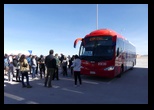

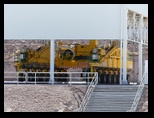
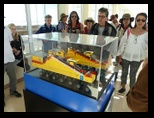
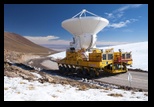
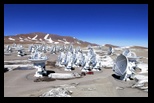
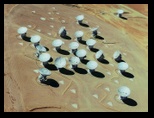
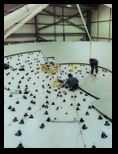
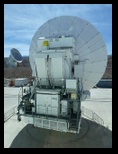
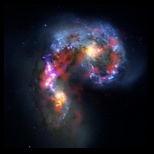
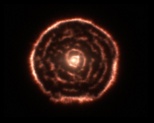
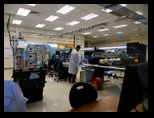

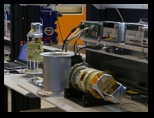
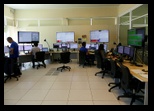
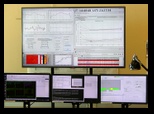
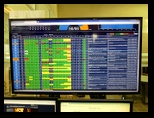
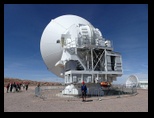
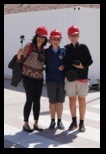
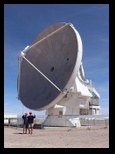
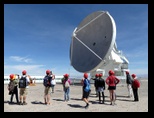
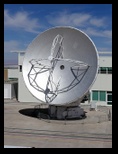
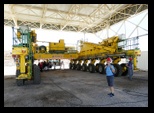
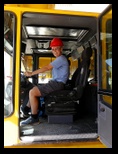
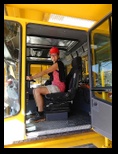
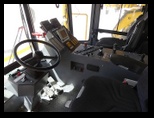
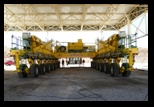
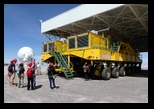
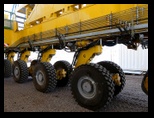

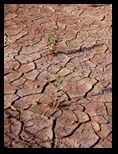
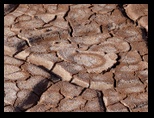
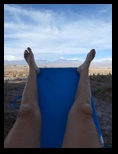
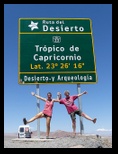
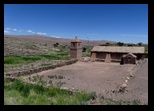






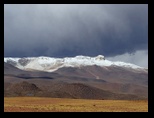

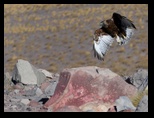

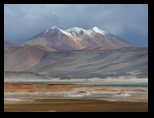

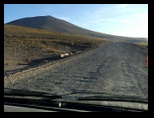
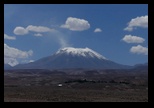
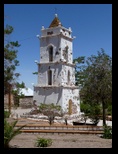
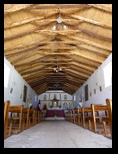
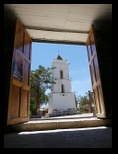
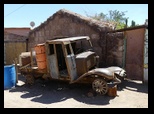
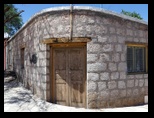

We set our alarm for 7-45am so that we could be ready for when the bus for the ALMA tour arrived at 8am. We had no reservation for the tour today and were just hoping we could get on either today or tomorrow.
The bus didn't arrive until 8-30am but we got our names onto the waiting list. We were at the top of the list so all we could do now was wait and hope that some people with reservations didn't turn up. Others came and put their names onto the waiting list but there were only about 30 people milling around. The tour is for up to 50 people so we thought we'd get on. What we didn't realise was that there were already a group of people on the bus who'd been picked up from a hotel in the town.
We got our things out of the motor home and Kirsten drove it to the nearby Quechua Hotel where we could park securely for the duration of the tour - approx 4 hours. She came back as the tour guide Paula was reading out names from her very long list of people with reservations and, one by one, people were getting onto the bus. She called out a lot of names but only about a third were here.
In the end, there were 8 places left and 6 people on the waiting list. So we all got on. We had to show our passports as ID and got onto the bus. Great!! We've made it. The bus left just after 9am and during the 40 minute ride out we were shown a video with all the safety precautions.
The centre is approx 35km east of San Pedro and we had to go through a check point just off the main road before heading up to the visitor centre which is at 2,900m.
ALMA has 66 radio telescopes that are the most powerful telescopes in the world of their kind. They observe the Universe at different wavelengths from sub-millimetre to 900 gigahertz and these ranges are split into ten sectors. They currently have eight of the ten working and the other two are still being built. Since water vapour strongly absorbs these wavelengths, it is critical for ALMA to be located in a very high and dry place. These requirements are perfectly met on the Chajnantor Plateau, at an elevation of 5000 metres in the Chilean Andes.
We weren't allowed to go up to the plateau which was another 25km further along the road up into the hills and once at the visitor centre our first stop was the toilet block! The tour would be at least 2 hours and, as usual, there was only one toilet for the ladies but three for the men.
The group was split into two - Spanish and English. Our tour leader was Paula who was busy answering questions that, no doubt, she has answered several times before, whilst we waited for the whole English group to assemble. There were several Brazilians in our group who don't speak Spanish so they preferred English.
The first information was about the facilities here. They have a natural gas power plant and four large water cylinders that are filled up by trucks from Calama. Even their food is delivered from the large town which isn't surprising seeing as San Pedro only has small shops and no supermarkets. A new residence facility has just been built but is not open yet. They are still using small white container-like houses. 200 people work here and 80% are Chilean and include electrical engineers who are very important.
The site is manned 24 hours a day and the 66 telescopes are from different countries - 25 from America, 25 from Europe and 16 from East Asia. Each countries telescopes have a different outer design but the technology is basically the same. Four of the ones from East Asia are the same size as the American and European ones (12m diameter) but 12 are smaller and are only 7m diameter. These smaller ones are always used together as a group and are used as scouts.
The telescopes are kept in one configuration for 3 months and then it takes a month to move them to a different configuration. They can be dotted over a 16km area to watch a concentrated area of dark space or they can be moved within a 4km area to watch a wide area of space. Weather doesn't affect them but they close in February every year as it is usually the worst month for rain and snow. Except for this year when it was January!
The wind can make the telescopes vibrate which affects their performance and if it is stronger than 70km per hour they shut down. Apparently that happens a lot!
The construction of the facility was started in 2003. Before that the various countries had developed the technology but were working alone. They pooled together and formed this joint venture at ALMA.
Projects are submitted well in advance and the best are accepted and the astronomers get the chance to either come to ALMA or work from home using one of the technicians here. America and Europe each get 20%, Chile gets 10% and the rest are divided between all the other countries. Chile doesn't always use up its quota. It's free for the astronomers but Paula couldn't tell us the cost of running the facility.
After all this information we went upstairs into the visitor centre and got the chance to see two telescopes that were outside - one European and one Japanese. There were lots of photos in the viewing corridor. Some showed photos from Hubble and then more detail from ALMA was added. The ALMA telescopes show clouds of very cold gases so there is far more detail. The first pictures came in 2011 when only three telescopes were operating. They were fully operational in 2013 so it took 10 years. They had ground breaking results in 2014 when they separated the telescopes 15km apart and got new information that even Hubble couldn't pick up. The photos were amazing.
We also saw a Lego model of the uniquely designed transporter vehicles. The ability to reposition the telescopes is extremely important but the telescopes, which are constructed from state-of-the-art precision components, each weigh over 100 tonnes, so moving them around requires specially designed vehicles. Engineers had to build vehicles rugged and durable enough to transport an antenna safely along the 25 kilometre road from the Operations Support Facility at an altitude of 2900 meters to the Chajnantor Plateau at an altitude of 5000 meters above sea level, as well as to move them to new positions on the plateau as necessary.
ALMA uses two of these enormous transporters, which have been named Otto and Lore. The twin vehicles are 20 meters long, 10 meters wide and 6 meters high, and each has 28 tyres. Even empty, the vehicles weigh in at 130 tons apiece. It takes a lot of power to move that much weight, so each vehicle comes equipped with two approximately 700-HP (500 kW) diesel engines and two 1500-litre fuel tanks. When transporting the telescopes they drive at 6km/h. Despite their bulk and power, these bright yellow behemoths are able to position the telescopes to within a few millimetres, ensuring accurate placement on the foundation pads.
There are 200 power points up on the plateau because the receptors (the most important part of the telescopes) need to be kept at 4 ° Kelvin which is minus 269° Celsius. Downstairs we could watch through a window into a static free maintenance area where an engineer was taking the outer shell off one of the receptors.
We also watched a short 15 minute video showing the idea behind the concept of ALMA and the construction work and also got the chance to go into the control room. At the time there were 56 out of the 66 telescopes in use and there was also a live feed to the plateau so we could see the telescopes.
The final part of the tour was to go out and see one of the huge transporter vehicles and we were even allowed to sit inside for photos! The tour lasted for 2.5 hours and was 4 hours altogether including transport to and from San Pedro. It was a really interesting tour and we would highly recommend it.
Free tour at ALMA
We met lots of people, in particular, Durval and Monica from Rio de Janeiro. We spent most of the tour chatting to them. They booked their tour online a month ago and Durval is a hobby astronomer. He travels with his own telescope and goes to the best spots to gaze at the stars. Before this trip to ALMA his favourite place was the Mojave desert in Arizona.
We got back to San Pedro just before 1pm and then went to the hotel where we'd parked Winnietwo. It cost us 2,400 pesos ($4 US) for secure parking for 4 hours which we gladly paid. We could also use their bathrooms to empty and clean our toilet and fill up with water so it was well worth it.
We parked back at the parking area for lunch and to plan our route and then drove along extremely bumpy and rutted narrow roads to the petrol station in town. The trucks can't make it here and have to fill up in Calama almost 100km away. It's a wonder the coaches can get down here - it's the most difficult petrol station to get to and they should have one outside the town.
We drove out to Laguna Cejar but they wanted 15,000 pesos ($25 US) per person for the entrance fee which we thought was ridiculous. Of course, Kirsten actually said that to the woman at the barrier who was not amused! She wouldn't even let us go into the car park to turn around so we had to get the car behind us to reverse so we could turn around and get out! We drove to the "lonely tree" which is the only place for miles with shade and parked up at 5-15pm. I spent almost an hour doing the cleaning and dusting ritual after all the gravel and dust roads we'd driven along and madam got her lounger out. Of course I had to take her cup of tea out to her aswell!!
The next day we spoke to a Turkish couple who had rented a camper van for three days and had just done the Paso Sico route which we were about to drive. So we got up to date info on the state of the road and gave them lots of tips for their trip. They told us that the other nearby Laguna Tebinquinche charged 2,500 pesos per person so we didn't bother driving that way and just went back out onto the main road and headed straight up to Paso Sico.
The road was tarmac up to Lake Miscanti (a short drive uphill to a lake that charges 3,000 pesos per person) and for another 19km afterwards. Then we hit gravel. If we had time we would visit Miscanti on the way back but the road was not very good and took us too long.
We got up to the Salar de Talar and the Piedras Rojas (red rocks) and Kirsten went off for an hour to take photos. We parked on the road as the drop off down to an area where we could park was too steep. So I stayed with the motor home and used the binoculars to see the salt lake with a beautiful turquoise lake and the rocks.
 Piedras Rojas - 360° Panorama
Piedras Rojas - 360° Panorama
(move mouse over panorama and click on the arrows)
We continued along the bad road for another 15km up to Laguna Tuyaito for a quick photo and then we had to turn around. It was already 6pm and we knew we would end up driving in the dark. It's a good job we marked a possible overnight stop at a parking area where there was a Dixie toilet on our GPS because otherwise we would never have found it in the dark. It was 8-30pm by the time we got there.
On the way to Paso Sico
The next day we continued downhill heading back towards San Pedro. We passed the small village of Socaire and stopped in Toconao for lunch and a quick photo stop at the church. We went to the entrance gate for Quebrada de Jerez, a small canyon, but there was another entrance fee. It seems that you have to pay for everything in this area and seeing as we have seen many canyons we gave this one a miss.
We stopped at a picnic and camping area 12km from Toconao and planned to stay the night but a ranger came along and said we weren't allowed to camp here. They must have changed this recently because according to iOverlander others have stayed overnight here. Oh well, we just drove back to the plaza in San Pedro for the night instead.